

Consolarium blog
As well as dong a lot of work at the Consolarium on Games Based Learning and Games Design we also research and investigate other technologies that we think will have a real impact in the classroom. In the last 12 months this has included 3D printing, mobile Apps, social software, multi-point and tablet technology.
One of the technologies that we see real potential in at the moment is GPS and Geocaching. We will be publishing a whole heap of resources and ideas to help support schools with this sometime before the summer.
As part of the recent Games to Learn Conference we ran a Geocaching workshop to help introduce practitioners into what GPS and Geocaching is and how it might have real education value. The weather was spectacular for the workshop and 30 educators had a great time treasure hunting around Dundee.
Have a look at the picture below:
Can you see the joy and excitement on their faces? This is impact of finding your first Geocache – pure excitement! The video below explains what Geocaching is:
During the workshop at Game to Learn participants had an opportunity to find some cashes from geocaching.com. These were mainly magnetic cashes and hidden around the city. We also hid some of our very own Consolarium Cashes and cryptic questions for people use their GPS to find and answer.
Using a GPS with pre-loaded co-ordinates our Consolarium adventures had to complete the following tasks:
1) Uncover a micro magnetic cache in the middle of the city (who would have know it was there!) -
2) Collect a sticker from inside a false rock in the graveyard -
3) Explore the history of Dundee by taking a crayon rubbing of the historic plaque (also works well with trees, statues and grave stones!) -
4) Find out about Roman Numerals and the height of the water at the HMS Discovery -
5) Take a digital picture of an engraving on the roof of a landmark that you would never normally see unless you stood in exactly the right place and looked up - 
6) Record and answer in audio using their mobile phone or talking tin -
As well as the above the groups has to work as a team, persevere and look after each other while they were alone in the city! They all did very well!
@OnTheSuperFly recorded the journey of his group really well as a series of Flickr Images and an associated blog post. Most of the above photos are his as well.
When he got home Andrew McLaughlin re-created the excitement as a Go-Animate Animation! GoAnimate4Schools.com: Geocaching #gametolearn by Andrew McLaughlin
In summary, at the Consolarium we think geocaching and educaching had huge potential in schools to help support learning and we will be writing more about this very soon!
MoreWow! What a response we have had to our Game To Learn afternoon practical workshops! More than half are fully booked and only a few spaces left in the others! As you can see from the table below, we’ve had great interest in our Game Design work shops that focus on Scratch, Build Your Own Blocks, Kodu, RPG Maker VX and 2Simple’s Purple Mash /2DIY as well as Thinkworlds 3D environment building session.
This demonstrates just how keen educators are in Scotland to equip themselves with skills to deliver the Game Design CfE outcomes in their classrooms. What is even more great to see is that it’s not just Computing teachers taking advantage of the sessions, but practioners from all over the curriculum - secondary and primary.
The three sessions that still have spaces in them promise to be an engaging experience for everyone involved.
NB - We will keep you updated via this blog and twitter (follow @gametolearn and the hashtag #gametolearn) should we receive any cancelations or find some more space in any of the full workshops.
|
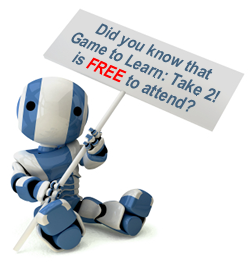 The Consolarium in partnership with JISC are delighted to be bringing the Game To Learn conference to the University of Abertay Dundee on Saturday 19th March.
The Consolarium in partnership with JISC are delighted to be bringing the Game To Learn conference to the University of Abertay Dundee on Saturday 19th March.
The Saturday Programme offers both a fun-packed CPD event for teachers as well as a celebration of the diverse and innovative practice in games-based learning and game design that has been happening in schools across Scotland. Over the past few years the LTS Consolarium initiative has been working with partner schools across Scotland to help nurture the idea that commercially available computer games, that have been developed for entertainment, can be used to help create appealing, purposeful and challenging contexts for learning.
Game Design also offers learners of all ages to engage with the creative process in an engaging and contemprary way that really can facilitate effective CfE delivery. Throughout the morning seminars and afternoon workshops, delegates will have the opportunity to hear from practioners and their use of game design and get some hands on time with game design tools.
Half of the sessions are already fully booked so book your place now to avoid disappointment.
Sessions that are still available include, but not limited to ….
Read about our work with Nintendogs and the Nintendogs case study
Read about our work with the Kinectimals and our Professor Layton case study.
Read about our work with the Eyepet and Gerry’s experiences with Game Based Learning, and others’ experiences in the futurelab report
This may be especially of interest to languages teachers, active school coordinators, PE teachers, class teachers and deputes from Primary and Secondary schools who are interested in seeing how ‘subject specific’ game based learning projects can impact on the whole school.
Read about our work with Just Dance and My French Coach.
Phew! What a start to the day! Follow up your morning seminar with a spot of free lunch, the chance to talk to industry exhibitors then on to a practical, fun filled hands on session. Workshops still available include, but again not limited too..
Using RPG Maker VX to Help Tell Stories & Make Connections Across Learning
Mathew Reid, English Teacher, Garnock Academy, North Ayrshire
“If you’re asking, I’m dancing!” – Join Us for the Just Dance-athon!
Fiona Ferrie, PE Teacher, Doon Academy
Derek Robertson, National Adviser, Consolarium, Learning and Teaching Scotland
Purple Mash: Glow Resources and Game Design with 2DIY
Alan Yeoman, 2Simple Software
Playful, Outdoor and Blended Learning Using GPS
Ollie Bray, National Adviser for Emerging Technologies in Learning, Learning & Teaching Scotland
What are you waitng for? Get your game on now … for FREE!
Hope to see you all on Saturday 19th March 2011
When the Consolarium team talk about the use of games in schools they always talk about the benefits of creating learning opportunities that are situated within the cultural framework of learners. We feel that this is one of the main reasons as to why our ideas in using Guitar Hero for example worked so well. This game initially built for entertainment has become very popular thanks to the initial ideas and practice that showed how ‘traditional learning’ such as writing could be made even more appealing, relevant and purposeful to learners.
Steve Bunce shares this view. He currently leads CPD for teachers in England through his work with Vital and has been a major player in building understanding, practice and capacity for game based learning in schools in England. One of the projects that Steve has been working on recently has involved a skateboarding game that works with the Wii, Skate it. Have a look:
This video review shows the game and the controller in action.
I managed to grab a few minutes of Steve’s time at the Learning Without Frontiers conference in London earlier this week where he gave me an explanation of what he has been doing with this game. Have a listen
Another speaker at this event proved to be incredibly interesting and much of what he said gave me some food for thought in terms of the riole that open source software can be used in schools. Evan Roth is an artist who works in Paris. work is in the permanent collection of the MoMA (NYC) and has been exhibited widely in the Americas, Europe and Asia, including the Pompidou (Paris), the Kunsthalle (Vienna), the Tate (London), the Fondation Cartier (Paris) and the front page of Youtube. Roth has received numerous awards for his work, including the Golden Nica from Prix Ars Electronica, Rhizome/The New Museum commissions (2007, 2009), the Future Everything Award and Brit Insurance Designs of the Year (1, 2).
He is also a co-founder of Graffiti Research Lab and the Free Art & Technology Lab (F.A.T. Lab), a web based, open source research and development lab.
Have a look at how they have subverted this Michael Jackson performance using open source software:
Evan Roth provides full access to all the materials and code associated with this clever piece of work from this part of his site.
Some of these ideas might be just outwith the boundaries of education in schools for some but the more we see how contexts that engage learners due to the experiences and content being something that sits within their cultural framework, is something that resonates with them, excites them - then maybe we should be exploring the practical application of these so that we can really meet learners needs and help them grow and flourish.
MoreWhat would it take to begin to explore what an electronic circuit is with very young children? What if all you had was a piece of paper, a paintbrush, a battery and a jar of ink…not any old jar of ink but one that ‘can create custom electronic circuitry on the skin as well as any surface where water-based paints would be appropriate. Bare can be applied with a brush, stamp or spray and is easily removed with soap and water.’
At the Learning Without Frontiers Conference this week I met with the people from Bare Conductive and was introduced to this very interesting resource. Their table and layout was strange because there was no digital tech, no games , no screens - all I saw were pieces of white paper with ink drawings on them scattered on a desk. When I asked them what they were showing they told me that they had an ink that could conduct electricity. I said, “Show me.” This is what I saw:
As you can see the battery at one end of the drawing is sending a current to the bulb at the other, all via the ink on the paper!
I really was astonished at this ingenious idea and at what appears to be an apparently simple technology. Immediate ideas began to spring to mind about its potential use in schools in relation to expolring circuits, especially when using a 2p piece was used as a resistor simply by sliding it up and down the line of ink, but there must also be teachers from the CDT and Art and Design domains who could no doubt look at ways in which this material can be incorporated in to pupils work.
As yet this ink is not available to buy but we have registered an interest with the people at @bareconductive to see if we can have get our hands on this material so that we can try it in schools. Anyone interested in having a look?
More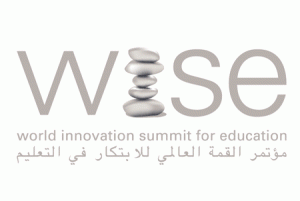 Last week we had the great honour of representing Scottish Education at the WISE Conference in Qatar. WISE is an initiative of Qatar Foundation for Education, Science and Community Development, under the aegis of Her Highness Sheikha Moza bint Nasser.
Last week we had the great honour of representing Scottish Education at the WISE Conference in Qatar. WISE is an initiative of Qatar Foundation for Education, Science and Community Development, under the aegis of Her Highness Sheikha Moza bint Nasser.
“WISE is based on the practical awareness that the challenges in education are no longer bound by countries’ political boundaries and, therefore, its mandate is international. WISE recognises that the challenges facing the world community have never been greater - that we need innovative solutions not achieved by traditional approaches alone. WISE asserts that the desire to innovate is, in fact, an innate human need to shape and improve our environment.”
At one of the seminars I attended I had the pleasure of listening to Marc Prensky talk about his developing thoughts about ‘Teaching Digital Natives,’ (the title of his new book). I have always found Marc Prensky a good reference point particularly back in the early 2000s when I was in the early stages of exploring the theoretical aspects of games based learning. During this period Prensky’s Digital Natives vs Digital Immigrants thesis had just come out and to me it seemed to capture a moment in time where people in education were really beginning to become aware of the mismatches between that of pupil experiences and expectations of tech at home and at school. I found that this concept gave some meaning to my own experiences and to that of very many of my colleagues working in education.
Over the years Prensky’s thesis began to be questioned. People wanted evidence to back his ideas up and I 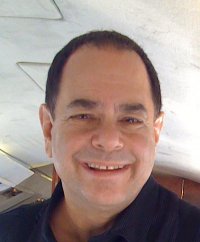 think it is fair to say that it became more and more apparent that although young learners were more at ease with technology than many of their teachers it was not necessarily the case that they were as ‘able’ with this technology than was possibly being assumed. In my experience one of the main issues about the lack of digital skills of these so called Digital Natives aspect was their lack of ability to access, analyse and synthesise information they found on the web rather than simply copying and pasting it in to a Word document to be then handed in as their own work.
think it is fair to say that it became more and more apparent that although young learners were more at ease with technology than many of their teachers it was not necessarily the case that they were as ‘able’ with this technology than was possibly being assumed. In my experience one of the main issues about the lack of digital skills of these so called Digital Natives aspect was their lack of ability to access, analyse and synthesise information they found on the web rather than simply copying and pasting it in to a Word document to be then handed in as their own work.
As I listened to Marc Prensky at WISE2010 I tweeted a few comments that were taken from his very short talk. These touched on some of the issues that have been associated with his work and ideas. I was particularly interested on his emphasis on what he described as ‘passion based teaching’. This was described as finding out what each child is passionate about and focusing on some way in on that. The practical application of this approach in a classroom of almost 30 learners was something I wanted to explore further with Marc and some of my tweets touched on this aspect of his talk. Later that evening Marc and I had a chat about perceptions of his talk and the danger of Twitter reducing the message in such a way that one might be misquoted or the message be ‘reduced’. Marc kindly accepted my offer of a quick interview where he could answer some of the questions that many of my colleagues like to explore when his ideas come up in discussion. The questions we discussed included:
You can hear the interview with Marc Prensky here:
Part 1:
A transcript of this discussion: Consolarium meets Marc Prensky part1
Part 2:
A transcript of this discussion: Consolarium meets Marc Prensky2
Many thanks to Marc Prensky for agreeing to be interviewed. Any comments about what he has said or about your take on the Digital Natives vs Digital Immigrants debate are most welcome.
MoreAs a result of presentation about the work of LTS’ Consolarium initiative in Strasbourg last year we were kindly invited to present a keynote talk about the place and value of game based learning in Scottish schools at a teacher technology conference in Bergen.
A few weeks back we received a call from a journalist from the Bergen Times whose interest in what was happening with the Consolarium in Scotland was sparked by his reading of the forthcoming conference’s programme. He told us that he had carried out a bit of research and would really like to see this for himself. A date was duly arranged and his flight to Aberdeen from Bergen allowed us to call on out colleagues in Aberdeenshire to showcase the GBL work that is happening in their schools.
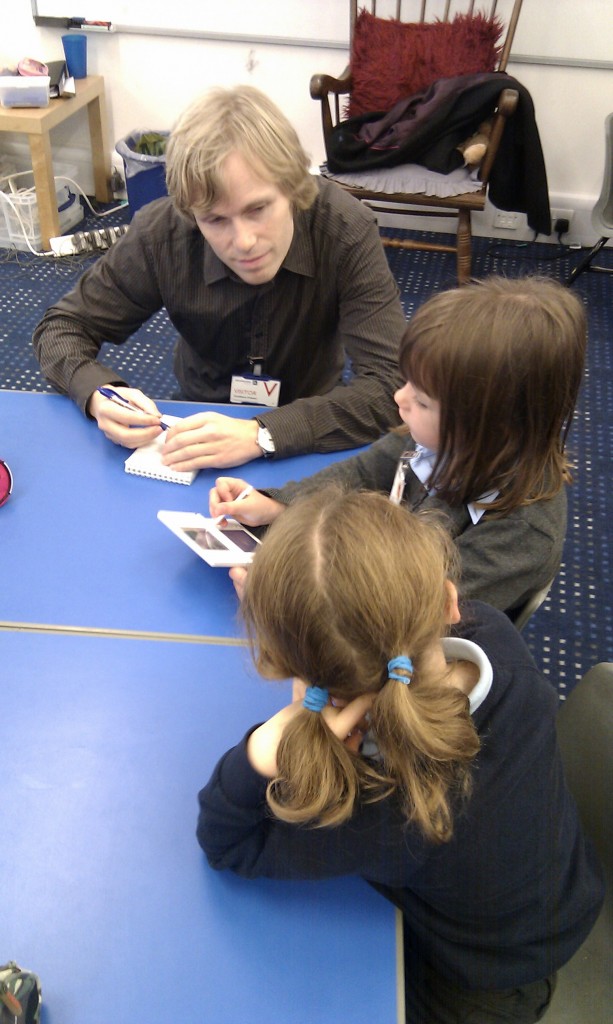 A programme was duly organised and the Norwegian journalist and his photographer spent a day visiting schools who were using a range of computer games in the classroom.
A programme was duly organised and the Norwegian journalist and his photographer spent a day visiting schools who were using a range of computer games in the classroom.
It appears that the game based learning approach that we employ in Scotland is new to Norway and as such it merited a real splash in the Bergen Times Weekend supplement, including a feature on the front cover! It appears that the journalist was somewhat taken aback by the power of what he witnessed in the classrooms he visited and as such he has written a very positive article about GBL in Scotland and what questions Norway can begin to ask itself about how the Consolarium’s ideas, practice and approach might begin to be developed over there.
The article is not online as yet so in the meantime please find attached .pdfs of the article:
Bergen Times Weekend Saturday Supplement main article
Page1: Photograph of kids playing Guitar Hero
There was also a piece following on from the main article that focused on asking schoolchildren from Bergen what they thought about having game based learning in school.
Page 1: Bergen schoolchildren and GBL
Page 2: Bergen schoolchildren and GBL
Finally, there was also a piece in the Sunday edition of the Bergen Times that included comments from prominent Norwegian educationalists about the work of the Consolarium in Scotland.
Bergen Times Sunday edition article
In order for you to make sense of these article we have attempted to use Google Translate so that you can make some sense of the stories featured in the Norwegian press. The translation has worked well although we do think that some meaning has been lost in translation.
There are also some errors in detail in the article that need to be highlighted and corrected:
It appears that the input that we gave at the conference has been well received and has at least started a discussion about the place of game based learning in Norwegian schools. The Bergen Times article has certainly helped!
MoreAs you probably know the Consolarium team was invited to the Games Based Learning 10 conference in London at the end of March. We presented on aspects of our work and if you click on you can follow the links to the videos of our presentations. ( Derek Robertson, Ollie Bray, Brian Clark and Brian McLaren)
During my own presentation there was a bit of a technical hiccup which prevented a couple of the embedded films, produced by teachers Mr Simpson (@familysimpson on Twitter) from Inverurie Academy and Mr Tait (@scotsnick on Twitter) from Grangemouth High, from working properly so I have embedded them here.
PS don’t forget to send in your MarioKart Times!!
MoreHaving just returned from the Handheld Learning Festival I thought I would share some thoughts about what I saw and what we brought to the festival.
There was a range of thought provoking and interesting speakers from Professor James Paul Gee, author of “What Video Games Have to Teach Us About Learning and Literacy”(2003) and “Good Video Games and Good Learning: Collected Essays” (2007)
Through personal reflections on education by Zenna Atkins, the Non-Executive Chairman of Ofsted, to Malcolm McLaren, artist and pop culture icon, as well as a host of others.
As well as these keynotes I also managed to hear John Davitt talk of the tools and technology available to teachers and his desire that we use these tools more productively. I was also delighted to see Tim Rylands, he of MYST fame, show work he has been undertaking with children using Wild Earth:African Safari.
Perhaps the highlight, for me anyway, was to be involved with the Spotlight Scotland Breakout, hosted by Learning and Teaching Scotland. It was standing room only for a series of 30 minute bursts of great practice and innovation in Scottish Education. Katie Barrowman gave a great presentation on GLOW which highlighted GLOW meet and the power of sharing, Derek Robertson introduced CANVAS (Children’s Art at the National Virtual Arena of Scotland) to the appreciative audience. My presentation was on the work undertaken by children in Clackmannan Primary and their teacher Morag Clark. You can watch a version of this below.
After a short break Lisa Sorbie from Perth High School showcased work an S1 class had undertaken with Hotel Dusk:Room 215, some great writing in the noir genre. Anna Rossvoll from Aberdeenshire showed the power of GLOW meet and Wii music introducing, live, a class from Peterhead who spoke to and performed for the audience in London. Ollie Bray concluded the session with a great presentation on the power of free tools for teachers. You can click this link for more on Ollie’s presentation.
More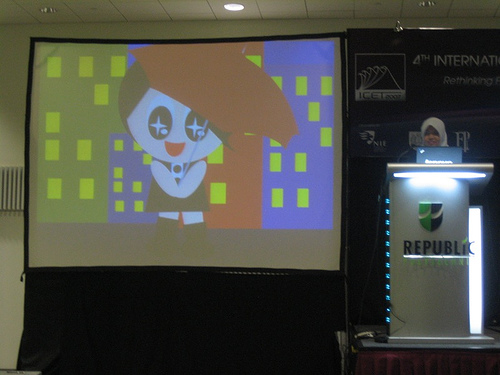 Sometimes simple ideas are the best. Amid all the high tech and new ideas I saw at the conference a very simple and yet very effective idea in relation to meeting the teachers learning intentions. Nur Ilyana was one of many teachers from Singapore at the conference whose work in classrooms had been recognised by the State. They were awarded a gong in recognition of their innovative and effective practice. Nur’s presentation was really quite enchanting and is something that anyone can do.
Sometimes simple ideas are the best. Amid all the high tech and new ideas I saw at the conference a very simple and yet very effective idea in relation to meeting the teachers learning intentions. Nur Ilyana was one of many teachers from Singapore at the conference whose work in classrooms had been recognised by the State. They were awarded a gong in recognition of their innovative and effective practice. Nur’s presentation was really quite enchanting and is something that anyone can do.
She is an Art teacher and she talked about how difficult it is to get children who feel that they can’t draw to engage with her subject in such a way that she can extend their knowledge, appreciation of and engagement with Art. What she did was introduce the concept of Shapes and Lines to the children and showed them how they could make impressive images by combining both. There was a real oriental feel to the images that were created and they were totally engaging. the children she had been working with were Year 5 and some of their work was hugely entertaining.
Once images were created using the drawing tools in PowerPoint Nur showed the children how to use custom animation tool within and how their images could then be made to move to music. The one that really caught my eye (and it is in the accompanying photograph for this post) was of Rhianna who recorded the song ‘Unbrella’. I’m going to email Nur to see if I can get a copy of this PPT because it was so simple and yet so effectice.
As I said, sometimes the simple ideas work.
More
Find us on